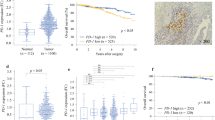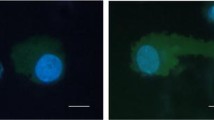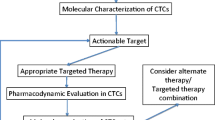Abstract
Background
Breast cancer is a highly prevalent disease among women worldwide. While the expression of certain proteins within breast cancer tumors is used to determine the prognosis and select therapies, additional markers need to be identified. Circulating tumor cells (CTCs) are constituent cells that have detached from a primary tumor to circulate in the bloodstream. CTCs are considered the main source of breast cancer metastases; therefore, detection of CTCs could be a promising diagnostic method for metastatic breast cancer.
Methods
In this study, the CircleGen CTC RT-qDx assay was used to analyze the mRNA expression levels of six CTC-specific markers including EpCAM, CK19, HER2, Ki67, hTERT, and vimentin with a total of 692 peripheral whole blood samples from 221 breast cancer patients and 376 healthy individuals.
Results
This assay showed high specificity with multiple markers; none of the healthy controls were detected positive, whereas 21.7 and 14 % of breast cancer patients were positive for EpCAM and CK19, respectively. Of the 221 breast cancer patients, 84 (38 %), 46 (20.8 %), 83 (37.6 %), and 39 (17.6 %) were positively for HER2, Ki67, hTERT, and vimentin mRNA, respectively. Of the 84 patients who were HER2 positive, nine (4 %) were also positive for EpCAM, CK19, Ki67, hTERT, and vimentin. Of the 139 breast cancer patients who were HER2 negative, 65 (29.1 %) were negative for EpCAM, CK19, Ki67, hTERT, and vimentin. Furthermore, the EpCAM-positive population decreased from 21.5 to 8.3 % after completion of anti-tumor treatment (TP4). Similarly, the CK19, HER2, hTERT, and vimentin positives also decreased from 13.9 to 9.5 %, from 37.7 to 21.4 %, from 37.2 to 33.3 %, and from 17.5 to 14.3 %, respectively, after completion of anti-tumor treatment. In contrast, the Ki67 positives increased from 20.6 to 41.7 % after completion of anti-tumor treatment.
Conclusions
mRNA overexpression of six CTC-specific markers was detected by the CircleGen CTC RT-qDx assay with high specificity, and the obtained mRNA expression levels of CTC-specific markers might provide useful criteria to select appropriate anti-tumor treatment for breast cancer patients.





Similar content being viewed by others
References
Coughlin SS, Ekwueme DU (2009) Breast cancer as a global health concern. Cancer Epidemiol 33:315–318
Breast Cancer Statistics. http://www.cancerresearchuk.org/. Accessed 23 May 2013
Ignatiadis M, Georgoulias V, Mavroudis D (2008) Micrometastatic disease in breast cancer: clinical implications. Eur J Cancer 44:2726–2736
Slade MJ, Coombes RC (2007) The clinical significance of disseminated tumor cells in breast cancer. Nat Clin Pract Oncol 4:30–41
Alunni-Fabbroni M, Sandri MT (2010) Circulating tumour cells in clinical practice: Methods of detection and possible characterization. Methods 50:289–297
Ignatiadis M, Georgoulias V, Mavroudis D (2008) Circulating tumor cells in breast cancer. Curr Opin Obstet Gynecol 20:55–60
Parikh RR, Yang Q, Higgins SA et al (2008) Outcomes in young women with breast cancer of triple-negative phenotype: the prognostic significance of CK19 expression. Int J Radiat Oncol Biol Phys 70:35–42
Elder EE, Xu D, Höög A et al (2003) KI-67 AND hTERT expression can aid in the distinction between malignant and benign pheochromocytoma and paraganglioma. Mod Pathol 16:246–255
Domagala W, Lasota J, Dukowicz A et al (1990) Vimentin expression appears to be associated with poor prognosis in node-negative ductal NOS breast carcinomas. Am J Pathol 137:1299–1304
Radhika K, Prayaga AK (2010) Estrogen and progesterone hormone receptor status in breast carcinoma: comparison of immunocytochemistry and immunohistochemistry. Indian J Cancer 47:148–150
Moretti E, Desmedt C, Biagioni C et al (2013) TOP2A protein by quantitative immunofluorescence as a predictor of response to epirubicin in the neoadjuvant treatment of breast cancer. Future Oncol 9:1477–1487
Swennenhuis JF, Reumers J, Thys K et al (2013) Efficiency of whole genome amplification of single circulating tumor cells enriched by Cell Search and sorted by FACS. Genome Med 5:106
Van der Auwera I, Peeters D, Benoy IH et al (2010) Circulating tumour cell detection: a direct comparison between the Cell Search System, the Adna test and CK-19/mammaglobin RT-PCR in patients with metastatic breast cancer. Br J Cancer 102:276–284
Raimondi C, Gradilone A, Naso G et al (2014) Clinical utility of circulating tumor cell counting through Cell Search(®): the dilemma of a concept suspended in Limbo. Onco Targets Ther 7:619–625
Müller V, Riethdorf S, Rack B et al (2012) Prognostic impact of circulating tumor cells assessed with the Cell Search System™ and Adna Test Breast™ in metastatic breast cancer patients: the detect study. Breast Cancer Res 14:R118
Andreopoulou E, Yang LY, Rangel KM et al (2012) Comparison of assay methods for detection of circulating tumor cells in metastatic breast cancer: AdnaGen Adna Test Breast Cancer Select/Detect™ versus Veridex Cell Search™ system. Int J Cancer 130:1590–1597
Amadori A, Rossi E, Zamarchi R et al (2009) Circulating and disseminated tumor cells in the clinical management of breast cancer patients: unanswered questions. Oncology 76:375–386
Wang HY, Ahn S, Kim S et al (2014) Detection of circulating tumor cells in patients with breast cancer using the quantitative RT-PCR assay for monitoring of therapy efficacy. Exp Mol Pathol 97:445–452
Hong B, Zu Y (2013) Detecting circulating tumor cells: current challenges and new trends. Theranostics 3:377–394
Riethdorf S, Fritsche H, Müller V et al (2007) Detection of circulating tumor cells in peripheral blood of patients with metastatic breast cancer: a validation study of the cell search system. Clin Cancer Res 13:920–928
Ntoulia M, Kaklamanis L, Valavanis C et al (2006) HER-2 DNA quantification of paraffin-embedded breast carcinomas with Light Cycler real-time PCR in comparison to immunohistochemistry and chromogenic in situ hybridization. Clin Biochem 39:942–946
Fehm T, Müller V, Aktas B et al (2010) HER2 status of circulating tumor cells in patients with metastatic breast cancer: a prospective, multicenter trial. Breast Cancer Res Treat 124:403–412
Maestro LM, Sastre J, Rafael SB et al (2009) Circulating tumor cells in solid tumor in metastatic and localized stages. Anticancer Res 29:4839–4843
Costelloe CM, Chuang HH, Madewell JE et al (2010) Cancer response criteria and bone metastases: RECIST 1.1, MDA and PERCIST. J Cancer 1:80–92
Acknowledgments
This study was supported by the Korea Health Technology R and D Project, Ministry of Health and Welfare, Republic of Korea [Grant HI12C18370100 (A121986) to HL] and the BK21 Plus Project, Ministry of Education, Republic of Korea (22A20130000035).
Conflict of interest
The authors declare that they have no conflict of interest.
Author information
Authors and Affiliations
Corresponding authors
About this article
Cite this article
Wang, Hy., Ahn, S., Kim, S. et al. Detection of circulating tumor cell-specific markers in breast cancer patients using the quantitative RT-PCR assay . Int J Clin Oncol 20, 878–890 (2015). https://doi.org/10.1007/s10147-015-0798-3
Received:
Accepted:
Published:
Issue Date:
DOI: https://doi.org/10.1007/s10147-015-0798-3




